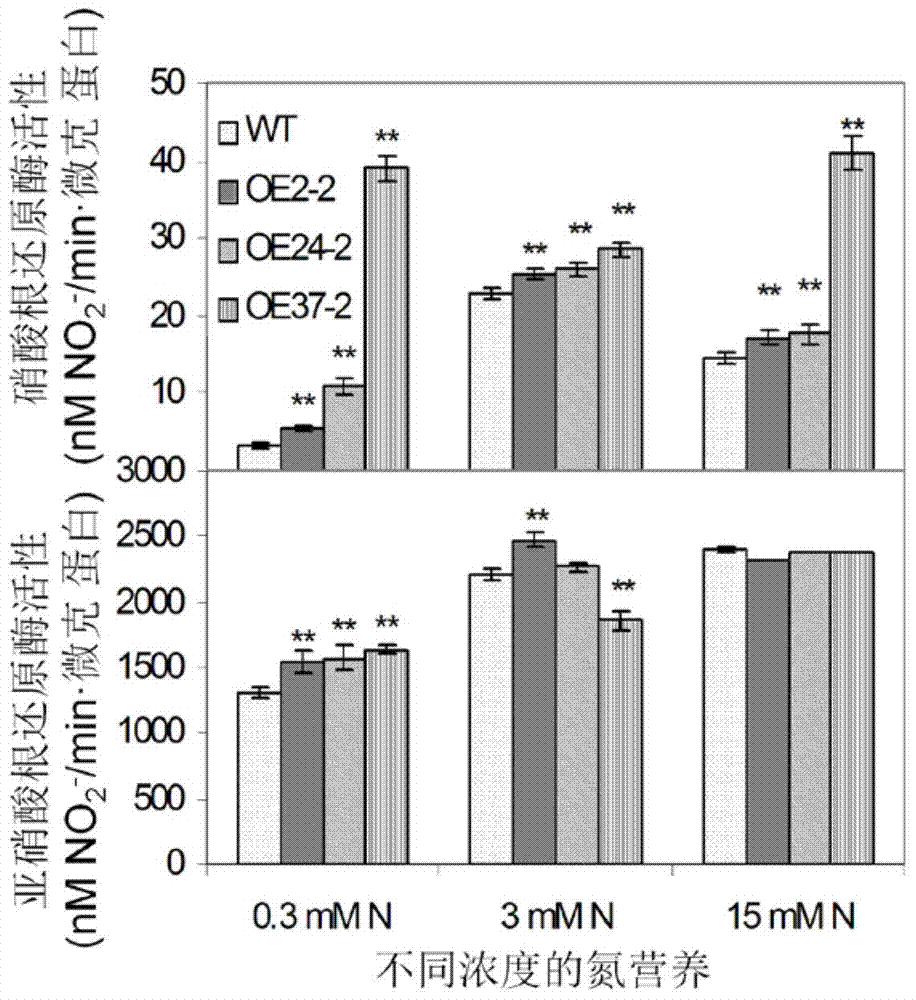Application of PLD (phospholipase D) epsilon gene in increasing nitrogen nutrition effective utilization and seed yield of crops
A nitrogen nutrition and gene technology, applied in the field of plant molecular breeding and biology, to achieve the effect of improving efficient reuse
- Summary
- Abstract
- Description
- Claims
- Application Information
AI Technical Summary
Problems solved by technology
Method used
Image
Examples
Embodiment 1
[0032] Embodiment 1: Rapeseed genetic transformation (dark light cultivation method)
[0033] Seed sterilization and germination: After soaking the seeds with 75% alcohol for 1 min, rinse the seeds with sterile water. Then use 0.15% HgCl 2 (containing 0.1% (v / v) Tween20) for 15 minutes, then rinsed with sterile water for 3-5 times; then sow the seeds in M 0 In the culture medium, 18 seeds were evenly sown per dish (3 cm in diameter). Put the petri dish into a sterile plastic culture box, and culture it at 25°C for 5 days under dark and light conditions.
[0034] Cultivation of Agrobacterium: Pick a single colony of Agrobacterium (GV3101, a strain containing the AtPLDα1 gene plasmid, purchased through a commercial channel) and put it in LB liquid culture medium (containing 50mg / L Km) for 1-2 days, the best The infection OD value is 0.6-0.8. Use a spectrophotometer to detect the concentration of the bacterial solution under the condition of 600nm light absorption. When the O...
Embodiment 2
[0044] Example 2: Identification and expression of PLDε transgenic plants
[0045] (1) Identification of PLDε transgenic plants
[0046] Transformed plants infected with Agrobacterium in M 4 After rooting was induced in the culture medium, an appropriate amount of leaf was taken to extract DNA, and the leaf DNA was detected by PCR with primer 35S-p / PLDε-A. The AtPLDε gene was successfully transferred. The electrophoresis results of the PCR products of some transformed plants showed that most of the plants could amplify fragments of the same size as the PCR products of the plasmid as a template, but only 2 transformed plants and WT DNA PCR products did not have target fragments, indicating that Agrobacterium The GV3101-mediated PLDε plasmid has been successfully transformed into rapeseed.
[0047] In the above method, the nucleotide sequences of the primer pairs used are as follows:
[0048] Primer pair 35S-p / PLDε-A:
[0049] Forward primer 35S-p5'-GAAGACGTTCCAACCACGT-3', ...
Embodiment 3
[0063] Example 3: PLDε-OE plants increase the absorption and utilization of N nutrients and seed yield
[0064] (1) Expression analysis of nitrogen transporter genes NRT1.1 and NRT2.1
[0065] In order to detect the absorption and utilization of N nutrients by PLDε, the expression levels of genes NTR1.1 and NTR2.1 related to N nutrient transport in plants were analyzed by Real-time. The data showed that: in severe nitrogen deficiency (0.3mM N) Under the same conditions, the expression levels of NTR1.1 in the leaves of OE24-2 and OE37-2 plants were significantly higher than those of the wild type, which were 4.5 and 1.5 times that of the corresponding WT plants, while those in the roots were 1.5 and 1.3 times, respectively. When plants were grown under the normal level of nitrogen supply (3mM N), the expression level of NTR1.1 in OE was 40 and 26 times that of wild type, and the expression level in roots was 0.7 and 1.9 times. Under nitrogen deficiency (0.3mM) conditions, the ex...
PUM
| Property | Measurement | Unit |
|---|---|---|
| length | aaaaa | aaaaa |
Abstract
Description
Claims
Application Information
 Login to View More
Login to View More - R&D
- Intellectual Property
- Life Sciences
- Materials
- Tech Scout
- Unparalleled Data Quality
- Higher Quality Content
- 60% Fewer Hallucinations
Browse by: Latest US Patents, China's latest patents, Technical Efficacy Thesaurus, Application Domain, Technology Topic, Popular Technical Reports.
© 2025 PatSnap. All rights reserved.Legal|Privacy policy|Modern Slavery Act Transparency Statement|Sitemap|About US| Contact US: help@patsnap.com



